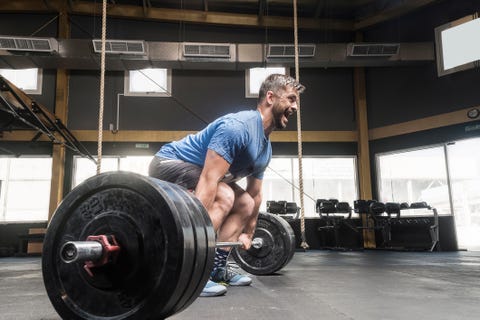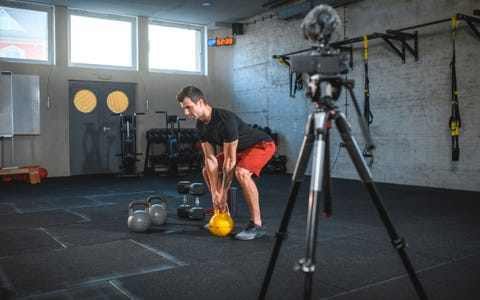You know you’re in for a long workout when the guy next to you grabs the biggest dumbbells on the rack and proceeds to throw them around with no regard for form, tempo, or even whether he’s still going to have working joints in ten years.
He’s looking around for validation, but anyone around him with any training experience just shakes their head. He’s not working out for any real purpose other than attention–in other words, he’s ego lifting. We’ve all seen that guy in the gym. If you haven’t, he might be you.
This type of workout isn’t just counterproductive for building muscle and strength. Training like this is more likely to land you in the hospital than put you on the path to your goals.
What is Ego Lifting?
Ego lifting is when someone (or even you!) attempts to lift more weight than they should, whether in the pursuit of muscle and strength gains or to impress any onlookers who happen to be using a nearby squat rack. While ego lifters may think they look impressive at the time, the most likely result is an increased chance of injury.
There are a few of dead giveaways that someone is prioritizing load and style over form, including:
Going Too Heavy
One of the biggest indicators of someone ego lifting is using a load that is too heavy for their goal or level of strength. It is not uncommon to see guys in the gym claiming to train for muscle growth, but using a load that only allows them to perform a few strained repetitions. While popular consensus holds that heavy load training improves strength, the sweet spot for muscular hypertrophy is largely believed to be at medium rep ranges (multiple sets of six to 12 repetitions). In other words, if someone can only eke out a few reps of a given exercise, they’re not going to build muscle.
Poor Control and Technique
Another telltale sign of ego lifting is poor control and technique. Going too fast, bouncing out of the top and bottom positions of a lift (like deadlifts or power cleans), swinging other body parts around to generate momentum, and jerking the weight around are all dead giveaways.
Of course, there is always a time where a grip-it-and-rip-it mentality is needed, especially if your goal is to build power—but for most trainees seeking muscle growth and increased gym-based strength, these techniques are best avoided.
Partial Range of Motion
A common sign that someone is lifting with their ego is a reduction in range of motion. We’ve all seen that guy load the leg press with stacks of plates only to move the sled two to three inches either way. The same applies to the barbell back squat, where people will not hesitate to throw another plate or two onto the bar, only for them to quarter-squat the weight.
Needless to say, if you cannot control the weight throughout a full range of motion, the load is likely too heavy for your current strength levels. You’d be far better off taking a step back and moving consistently through the full range of motion your strength allows.
Excessive Range of Motion
Conversely, excessive range of motion is also a sign that you might be lifting with your ego. Consider the barbell squatter who squats so deep that his lower back starts to round or the bench presser whose shoulders round over as they attempt to bring the bar to the chest. This excessive range often attempts to reduce tension in the target muscle and use other joints and muscles to work through the rep. While this may allow you to use heavier loads, it may result in a reduced stimulus to the target muscles and increase the risk of injury.
Working through the correct range of motion for each exercise is important to avoid injury and achieve your goals.
Training Through Pain
We’ve all heard the saying ‘no pain, no gain’. But is this something we should be actively chasing when training? The answer, of course, is it depends on the type of pain.
If an exercise results in a typical burning sensation within the muscle, it probably isn’t too detrimental to long-term progress. If, however, a particular load results in a different type of pain, such as a dull throb, sharp shooting pain, or a grinding sensation, it’s more than likely a bad thing and should not be dismissed. Look to reduce the load, slow down your movements, or potentially opt for an exercise that is more ‘joint- friendly’ to avoid making the issue worse.
Why People Get Stuck Ego Lifting
There are several reasons why people fall into the trap of ego lifting.
Trying to Keep Up With Others
Whether it’s training with a friend, competing with someone else at the gym, or copying the latest program from your favorite trainer’s social media page, trying to keep up with others is a fools’ errand—one that quickly leads to ego lifting.
While friendly competition is never a bad thing, the gym floor is arguably the most dangerous place to compete with others, especially with those who are bigger and stronger. In most cases, the risk of injury is too high for what is probably a low-quality training effect.
Not Assessing Your Form
While we often lament the guy who films every set, there is some benefit to filming your training. Firstly, it provides an honest and transparent check on technique and execution at any given load. Secondly, it allows for comparisons across a single set from the first rep to last or across sets as the load increases–consistency is key in both cases.
If your technique breaks down towards the end of the set, adding more load is unlikely to improve the quality of the work you perform. Likewise, if warm-up and feeder sets are performed across a specific range, then it’s sensible to ensure that your heavier sets are also performed within the same range.
In the pursuit of strength progressions and increased muscle, it’s easy to fall into the trap of increasing load at the expense of correct form. Left unchecked, this could turn what was once a textbook technique into a sloppy, shoddy lift governed only by ego.
Not Learning the Correct Form
It’s incredibly common for novice trainees to rush through the initial learning stages of resistance training. While understandable, taking the time to master a wide variety of exercises and perfecting the techniques, focusing on control and ownership throughout the full range of motion will reap better results long term. Not only are you more likely to build muscle and strength, but in doing so, you are less likely to hit training plateaus and sustain injuries. While lifting a lighter load may not seem as macho, it’s important not to underestimate the need for patience and taking pride in how you lift.
How to Avoid Ego Lifting
Use More Specific Tempos
Place a specific emphasis on the eccentric portion of exercises and pauses in the most difficult positions of the rep.
Use Moderate-to-High Rep Ranges
An eight to 12-rep range is considered the sweet spot for muscle growth, but don’t be afraid to go as low as eight or as high as 20 to 25 for some exercises (typically those when you would use lighter weights, where the goal is to improve your muscular endurance).
Train Through a Full Range of Motion
Establish the range of motion you have available at each joint and through which you can control the load. Aim to keep this range consistent for every single rep.
Master Good Technique
Take pride in how you lift and avoid chasing load for the sake of it.
Be Patient
Muscle growth is a marathon, not a sprint. It does not occur overnight. In fact, it’s likely to take months, if not years, to build the physique of your dreams. Be prepared for the long haul and ensure that you lift in a way that promotes joint longevity. It’s hard to build muscle if you are constantly injured and your joint health is compromised.
While nearly everyone is probably guilty of ego lifting at one time or another, it’s important to remember that ego lifting is not beneficial for long-term gym progress. Poor form can cause short- and long-term injuries and prevent you from gaining muscle and strength. You won’t look half as cool as you think you might with an injury, and most experienced trainees will see straight through your façade. If you really want to fulfill your fitness potential and make gains, leave your ego at the door.
Aroosha Nekonam is a Certified Personal Trainer at Ultimate Performance Gym.
This content is created and maintained by a third party, and imported onto this page to help users provide their email addresses. You may be able to find more information about this and similar content at piano.io




Comments are closed.